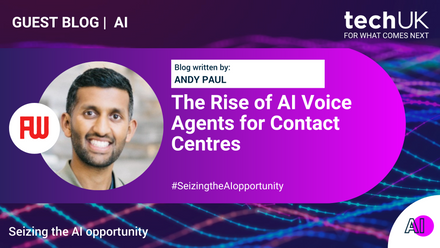Five barriers that are holding back the Government’s AI Opportunities Action Plan – and how to remove them
The transformative potential of AI presents one of the most remarkable economic opportunities of our time, with the UK’s AI market currently valued at more than £21 billion and forecast to reach £1 trillion by 2035. It’s expected that AI will have a profound impact on socioeconomic growth. The government’s much-anticipated AI Opportunities Plan sets out this pathway to growth for the UK with optimism and pragmatism, but it’s already clear that the plan is not going to be linear: there will be roadblocks, and addressing these in a systematic way will be fundamental to the effective delivery of the plan.
At Colt, our vantage point across the global technology industry - alongside our track-record in building secure, sustainable, next-generation fibre networks which are fundamental to the AI economy – means we’re well positioned to share our experience and insight. It’s why we’ve spent time over the last few months engaging with the UK government and stakeholders around the delivery of its AI Opportunities Plan, identifying key priorities around areas such as investment, talent and regulations. Through this work, we’ve shared five potential barriers to the plan’s delivery and have offered guidance and recommendations.
-
Compute capacity and digital infrastructure
Currently, the UK's general compute capacity is lower than comparators like France, Germany, Japan and the United States and it significantly lags in the GPU compute capacity that is critical for modern AI training and inference. Plans for the Exascale computer at the University of Edinburgh have been shelved and plans to spend £100m on 5,000 GPUs pales in comparison to the $10.5bn Meta is spending on around 50,000 Nvidia H100 GPUs.
Data centres – which have been designated critical national infrastructure status – play a vital role and must be prioritised as providers of essential services. The UK government must prioritise sustainable data centre construction, as McKinsey estimates that global demand for data centre capacity will continue to increase by around 20% year-on-year to 2030. With many of the UK’s data centres now starting to age, there is a growing urgency to upgrade these to enhance their energy efficiency, sustainability, capacity, performance and reliability ensuring they can meet the growing demands of AI and digital services.
Transit networks need improvement to facilitate the movement of data between different regions and countries, supporting national and international collaboration and data sharing. Additionally, access networks, such as high-speed internet and 5G, must be expanded to provide end-users and edge devices with the necessary connectivity for real-time data access and processing.
-
Energy Supply
Data centres and advanced AI processing are energy-intensive operations, accounting for around 2% of Britain’s total electricity demand according to the National Energy System Operator – a figure that is projected to quadruple by 2030. In Ireland, data centres are reported to account for around 21% of total electricity demand, forecast to rise to constitute almost a third by 2034. The high cost of electricity in the UK amplifies these pressures. Underlying this is the critical need to reduce carbon emissions and identify sustainable energy sources which positively impact the UK’s net zero ambitions.
Grid infrastructure is recognised as a critical bottleneck for achieving the energy transition and national growth plans, with delays to connect new energy supply projects and industrial conflicting with the rapid pace at which data centre demand is growing, and congestion in high-demand regions intensifying pressure. The Government has recently set out its plans for reforming the grid connection process and delivering new network infrastructure to align with its strategic planning for its clean power by 2030 mission. These infrastructure upgrades will be critical to delivery of the AI Opportunities Plan.
-
The regulatory environment
The pace of change in AI development demands a regulatory approach that is both agile and adaptable. The EU’s AI act has faced criticism from AI providers, who believe it is inhibiting innovation and imposing heavy compliance burdens, with a ‘one size fits all’ rules-based approach, regardless of the nature of AI applications. For the UK, a flexible, principles-based regulatory framework is needed, allowing UK businesses to respond dynamically to AI advances in a safe and responsible manner.
For the UK to remain an attractive destination for investment, it is crucial to establish a stable, pro-investment regulatory environment. The UK must ensure that AI regulations provide straightforward, principles-based frameworks that offer both stability and adaptability, while avoiding unnecessary complexity.
-
Investment
The availability of finance poses a significant barrier to the growth of the UK’s AI sector, with access to equity investment and external finance cited as short-term barriers to growth. Additionally, there are regional disparities which inhibit progress:
The highly competitive global landscape for AI investment further challenges the UK’s established position. While the UK remains a key player, attracting more than £3 billion in private AI investment in 2023 and ranking third globally, it lags behind China and the US. At a regional level, AI investment in the UK is predominantly clustered in London, which received over 70% (£822 million) of equity investment in 2023. This geographic imbalance limits the development of regional AI hubs, stifling innovation and economic growth outside of the capital. The UK government must take proactive measures to promote both national and regional access to finance.
-
Skills
A shortage of technical skills within the workforce is one of the most pressing barriers to the adoption and growth of AI technologies in the UK and the delivery of the government’s AI Opportunities Plan. Research from the University of Birmingham suggests the UK could face economic losses of up to £27.6 billion by 2030 due to digital skills shortages. The UK’s education system has been slow to adapt to the demands of emerging AI technologies, with businesses and academics highlighting a mismatch between industry requirements and educational output. In addition to upskilling the domestic workforce, the UK must attract and retain international AI talent to remain competitive globally.
By upgrading infrastructure, creating supportive regulations, attracting investment, leveraging regional strengths and developing a skilled workforce, the government can strengthen the AI ecosystem, encourage adoption across sectors, and position the UK as a global leader in innovation.
techUK - Seizing the AI Opportunity
For the UK to fully seize the AI opportunity, citizens and businesses must have trust and confidence in AI. techUK and our members champion the development of reliable and safe AI systems that align with the UK’s ethical principles.
AI assurance is central to this mission. Our members engage directly with policy makers, regulators, and industry leaders to influence policy and standards on AI safety and ethics, contributing to a responsible innovation environment. Through these efforts, we help build public trust in AI adoption whilst ensuring our members stay ahead of regulatory developments.
Get involved: techUK runs a busy calendar of activities including events, reports, and insights to demonstrate some of the most significant AI opportunities for the UK. Our AI Hub is where you will find details of all upcoming activity. We also send a monthly AI newsletter which you can subscribe to here.
Upcoming AI events
Latest news and insights
Subscribe to our AI newsletter
AI and Data Analytics updates
Sign-up to our monthly newsletter to get the latest updates and opportunities from our AI and Data Analytics Programme straight to your inbox.
Contact the team
Visit our AI Hub - the home of all our AI content:











